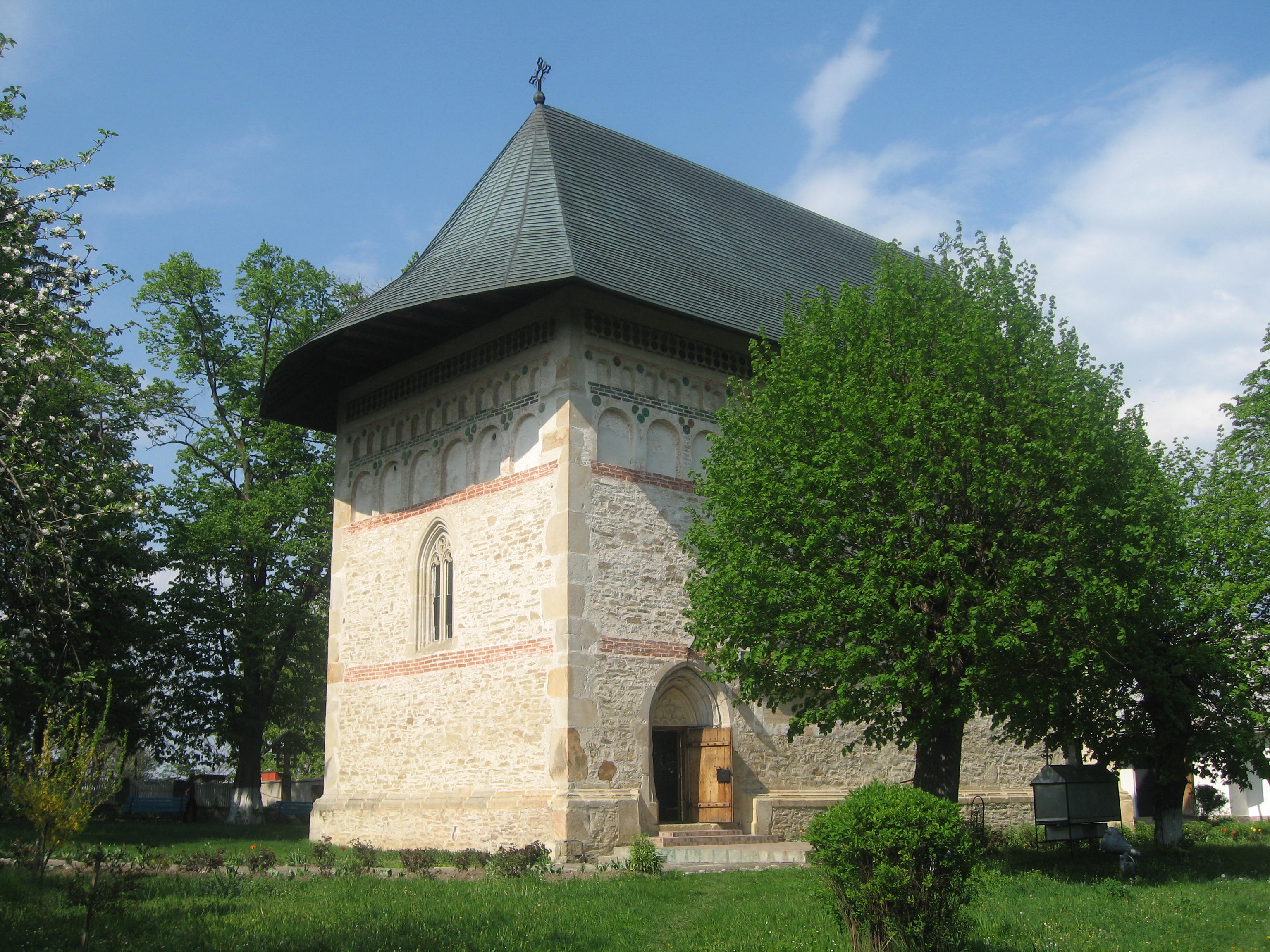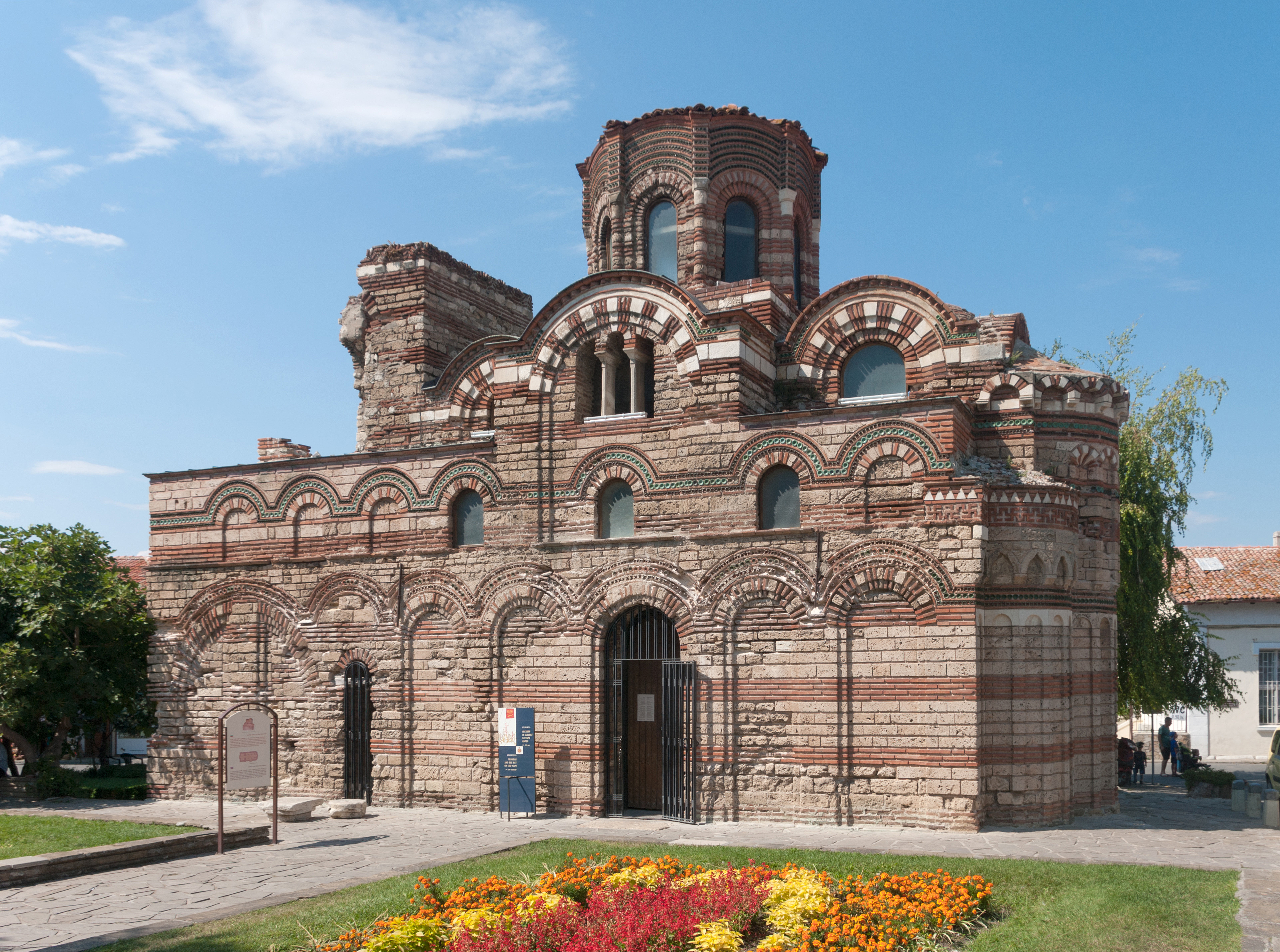|
Borzești Church
The Oneşti, Borzeşti Church (also known as The Church of the "Assumption of Virgin Mary" in Borzești) is an Orthodox church located in Onești, Bacău County, Romania. It was founded by Ştefan cel Mare (Stephen the Great), with construction lasting from July 9, 1493, to October 12, 1494. Ştefan cel Mare founded the church with his first-born son Alexandru of Moldavia, Alexandru, and the church was dedicated to Dormition of the Mother of God, the Assumption of the Virgin Mary. The church is said to also be in memory of a childhood friend of Ştefan cel Mare, Ştefan killed during the invasions of the Tatars. Legends say that the friend died under an oak tree where the church now stands. Architecture The church is designed in a mix of Moldavian style, Moldavian, Gothic architecture, Gothic, and Byzantine architecture, Byzantine styles. The buildings plan is rectangular with one rounded side, vaulted with four spherical domes, and lacks a spire. The domes are Byzantine inspired ... [...More Info...] [...Related Items...] OR: [Wikipedia] [Google] [Baidu] |
Gothic Architecture
Gothic architecture is an architectural style that was prevalent in Europe from the late 12th to the 16th century, during the High Middle Ages, High and Late Middle Ages, surviving into the 17th and 18th centuries in some areas. It evolved from Romanesque architecture and was succeeded by Renaissance architecture. It originated in the Île-de-France and Picardy regions of northern France. The style at the time was sometimes known as ''opus Francigenum'' (); the term ''Gothic'' was first applied contemptuously during the later Renaissance, by those ambitious to revive the Classical architecture, architecture of classical antiquity. The defining design element of Gothic architecture is the Pointed arch (architecture), pointed arch. The use of the pointed arch in turn led to the development of the pointed rib vault and flying buttresses, combined with elaborate tracery and stained glass windows. At the Abbey of Basilica of Saint-Denis, Saint-Denis, near Paris, the choir was rec ... [...More Info...] [...Related Items...] OR: [Wikipedia] [Google] [Baidu] |
Churches Completed In The 1490s
Church may refer to: Religion * Church (building), a place/building for Christian religious activities and praying * Church (congregation), a local congregation of a Christian denomination * Church service, a formalized period of Christian communal worship * Christian denomination, a Christian organization with distinct doctrine and practice * Christian Church, either the collective body of all Christian believers, or early Christianity Places United Kingdom * Church, a former electoral ward of Kensington and Chelsea London Borough Council that existed from 1964 to 2002 * Church (Liverpool ward), a Liverpool City Council ward * Church (Reading ward), a Reading Borough Council ward * Church (Sefton ward), a Metropolitan Borough of Sefton ward * Church, Lancashire, England United States * Church, Iowa, an unincorporated community * Church Lake, a lake in Minnesota * Church, Michigan, ghost town Arts, entertainment, and media * '' Church magazine'', a pastoral theology ma ... [...More Info...] [...Related Items...] OR: [Wikipedia] [Google] [Baidu] |
Buildings And Structures Completed In 1494
A building or edifice is an enclosed structure with a roof, walls and windows, usually standing permanently in one place, such as a house or factory. Buildings come in a variety of sizes, shapes, and functions, and have been adapted throughout history for numerous factors, from building materials available, to weather conditions, land prices, ground conditions, specific uses, prestige, and aesthetic reasons. To better understand the concept, see ''Nonbuilding structure'' for contrast. Buildings serve several societal needs – occupancy, primarily as shelter from weather, security, living space, privacy, to store belongings, and to comfortably live and work. A building as a shelter represents a physical separation of the human habitat (a place of comfort and safety) from the ''outside'' (a place that may be harsh and harmful at times). buildings have been objects or canvasses of much artistic expression. In recent years, interest in sustainable planning and building pr ... [...More Info...] [...Related Items...] OR: [Wikipedia] [Google] [Baidu] |
Medieval Architecture
Medieval architecture was the architecture, art and science of designing and constructing buildings in the Middle Ages. The major styles of the period included pre-Romanesque, Romanesque architecture, Romanesque, and Gothic architecture, Gothic. In the fifteenth century, architects began to favour Classical architecture, classical forms again, in the Renaissance architecture, Renaissance style, marking the end of the medieval period. Many examples of religious, civic, and military architecture from the Middle Ages survive throughout Europe. Styles Pre-Romanesque The pre-Romanesque period lasted from the beginning of the Middle Ages (around 500 AD) to the emergence of the Romanesque style (from the 10th century). Much of the notable architecture from the period comes from France and Germany, under the Merovingian art and architecture, Merovingians and the Carolingian architecture, Carolingians and the Ottonian architecture, Ottonians. Other regions also have examples of architect ... [...More Info...] [...Related Items...] OR: [Wikipedia] [Google] [Baidu] |
Churches Established By Stephen The Great
Church may refer to: Religion * Church (building), a place/building for Christian religious activities and praying * Church (congregation), a local congregation of a Christian denomination * Church service, a formalized period of Christian communal worship * Christian denomination, a Christian organization with distinct doctrine and practice * Christian Church, either the collective body of all Christian believers, or early Christianity Places United Kingdom * Church, a former electoral ward of Kensington and Chelsea London Borough Council that existed from 1964 to 2002 * Church (Liverpool ward), a Liverpool City Council ward * Church (Reading ward), a Reading Borough Council ward * Church (Sefton ward), a Metropolitan Borough of Sefton ward * Church, Lancashire, England United States * Church, Iowa, an unincorporated community * Church Lake, a lake in Minnesota * Church, Michigan, ghost town Arts, entertainment, and media * '' Church magazine'', a pastoral theology ma ... [...More Info...] [...Related Items...] OR: [Wikipedia] [Google] [Baidu] |
Nativity Of St
Nativity or The Nativity may refer to: Birth of Jesus Christ * Nativity of Jesus, the Gospel stories of the birth of Jesus Christ * Nativity of Jesus in art, any depiction of the nativity scene ** ''Nativity'' (Barocci), a 1597 painting by Federico Barocci ** ''Nativity'' (Campin), a 1420 panel painting by Robert Campin ** ''Nativity'' (Christus), a devotional mid-1450s oil-on-wood panel painting by Petrus Christus ** ''Nativity'' (Correggio), a painting finished around 1529–1530 by Antonio da Correggio ** ''Nativity'' (El Greco), ** ''Nativity'' (Geertgen tot Sint Jans) or ''Nativity at Night'', a painting of about 1490 by Geertgen tot Sint Jans ** ''Nativity'' (Lanfranco), ** ''Nativity'' (Masaccio) or ''Desco da parto'', a birthing-tray painted by Masaccio ** ''Nativity'' (Master of the Brunswick Diptych), ** ''Nativity'' (Parmigianino), ** ''Nativity'' (Simone dei Crocifissi), ** ''The Nativity'' (Burne-Jones), 1888 ** ''The Nativity'' (Piero della Frances ... [...More Info...] [...Related Items...] OR: [Wikipedia] [Google] [Baidu] |
Războieni, Neamț
Războieni is a commune in Neamț County, Western Moldavia, Romania. It is composed of five villages: Borșeni, Războieni, Războienii de Jos, Valea Albă, and Valea Mare. The commune is located in the central-east part of the county, on the banks of the river Valea Albă. It is situated southeast of Târgu Neamț and northeast of the county seat, Piatra Neamț. Războieni is crossed by the county road DJ208G, which connects it to the south to Dragomirești, Ștefan cel Mare, and Girov (where it ends in ) and to the east to Tupilați. 1476 Battle of Valea Albă The Battle of Valea Albă, also known as the Battle of Războieni, took place at Războieni on July 26, 1476, between the Moldavia Moldavia (, or ; in Romanian Cyrillic alphabet, Romanian Cyrillic: or ) is a historical region and former principality in Eastern Europe, corresponding to the territory between the Eastern Carpathians and the Dniester River. An initially in ...n army of Stephen the Great ... [...More Info...] [...Related Items...] OR: [Wikipedia] [Google] [Baidu] |
Byzantine Architecture
Byzantine architecture is the architecture of the Byzantine Empire, or Eastern Roman Empire, usually dated from 330 AD, when Constantine the Great established a new Roman capital in Byzantium, which became Constantinople, until the Fall of Constantinople, fall of the Byzantine Empire in 1453. There was initially no hard line between the Byzantine and Roman Empires, and early Byzantine architecture is stylistically and structurally indistinguishable from late Roman architecture. The style continued to be based on arches, vaults and domes, often on a large scale. Wall mosaics with gold backgrounds became standard for the grandest buildings, with frescos a cheaper alternative. The richest interiors were finished with thin plates of marble or coloured and patterned stone. Some of the columns were also made of marble. Other widely used materials were bricks and stone. Mosaics made of stone or glass tesserae were also elements of interior architecture. Precious wood furniture, like be ... [...More Info...] [...Related Items...] OR: [Wikipedia] [Google] [Baidu] |
Moldavian Style
Moldovenesc style or Moldavian architectural style is a type of architecture developed in Moldavia during the 14th through 19th centuries. The period of maximum flowering of this style was in the period of Stephen III of Moldavia. The Moldavian monasteries which belongs to the World Heritage Site, UNESCO heritage are made in this style. The period in which it developed most is the reign of Stephen the Great (1457-1504). Gallery File:Manastirea putna2.jpg, Putna Monastery in Suceava County File:Biserica Manastirii Neamt.jpg, Neamț Monastery in Neamț County File:Statuia lui Dosoftei din Iaşi2.jpg, Princely Saint Nicholas Church and Dosoftei House in Iași File:Căpriana monastery, 2007.jpg, Căpriana monastery in Strășeni District, Moldova File:Manastirea Bistrita 0002.JPG, Bistrița Monastery in Neamț County File:Biserica Sf. Gheorghe din Harlau6.jpg, St. George Church in Hârlău File:Piatra neamt1.cristibur.jpg, Stephen III of Moldavia's Tower in Piatra Neamț File:Biseric ... [...More Info...] [...Related Items...] OR: [Wikipedia] [Google] [Baidu] |
Tatars
Tatars ( )Tatar in the Collins English Dictionary are a group of Turkic peoples across Eastern Europe and Northern Asia who bear the name "Tatar (term), Tatar". Initially, the ethnonym ''Tatar'' possibly referred to the Tatar confederation. That confederation was eventually incorporated into the Mongol Empire when Genghis Khan unified the various steppe tribes. Historically, the term ''Tatars'' (or ''Tartars'') was Endonym and exonym, applied to anyone originating from the vast North Asia, Northern and Central Asian landmass then known as Tartary, a term which was also conflated with the Mongol Empire itself. More recently, however, the term has come to refer more narrowly to related ethnic groups who refer to themselves as ''Tatars'' or who speak languages that are commonly referr ... [...More Info...] [...Related Items...] OR: [Wikipedia] [Google] [Baidu] |





